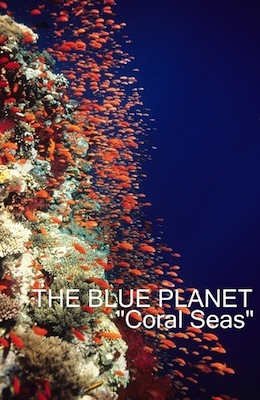Filtered By: Newstv
NewsTV
BBC’S 'The Blue Planet: Coral Seas'
BBC’S 'The Blue Planet: Coral Seas' Airing Date: October 6, 2012 From a single coral larva, an entire underwater city grows… Amazingly beautiful and complex, coral reefs develop from humble beginnings. Tiny colonial coral larvae settle and then, over hundreds of years, the intricate and fragile reefs that we so enjoy grow, inch by inch.  Bathed in warm, clear tropical water and bright sunlight, coral reefs are the rainforests of the sea. Diversity of color and design is nowhere more blatant. But it is no tropical paradise. Space is at a premium and even the coral itself fights to survive. Animals are often forced to share space, and some even find shelter in one another. The social shrimp lives within sponges and is the first marine animal to be found living in a society with a queen, similar to bees. Competition for food on a mature reef is so intense that some animals defend their food. The bizarrely adorned harlequin shrimps keep a starfish arm alive in their cave for fresh food. Algae-eating powder blue tangs defend their territories on the reef against other herbivores, only to be invaded by a vast school of convict tangs. A grouper defends a shimmering school of its own prey, glassfish, against hungry lionfish. Night on the reef is very different. There is a changeover of animals - most of the fish adopt a darker color for their night’s rest whilst the weird and wonderful invertebrates emerge. Moray eels slither around the corals hunting by smell. White tip sharks use their electrical sense to trace any movement from the sleeping fish. Feeding frenzies disturb the otherwise still, eerie calm of the reef at night. Haunting songs reverberate round the reef, heralding the arrival of humpback whales. These unlikely visitors come to coral reefs to breed in winter. Other animals breed year round. The amount invested in offspring ranges from great care such as the pipefish, to those who simply squirt millions of eggs and sperm into the sea in the hope that some will be fertilized. For corals, spawning requires fantastic synchronization. All the coral heads of a species in one place will spawn at the same time on only one night each year. As the storm develops off-shore, some creatures seek deeper water for safety. But corals cannot move and as the storm hits the reef, they get blasted by the waves. A big storm breaks the coral and flattens the reef. And only because the coral spawned and their larvae are ready to settle can a new reef begin again. Explore the richest and most colorful communities in the ocean as GMA News TV airs BBC's The Blue Planet “Coral Seas”, narrated in Filipino by Kara David, this Saturday, October 6 at 10PM on GMA News TV.
Bathed in warm, clear tropical water and bright sunlight, coral reefs are the rainforests of the sea. Diversity of color and design is nowhere more blatant. But it is no tropical paradise. Space is at a premium and even the coral itself fights to survive. Animals are often forced to share space, and some even find shelter in one another. The social shrimp lives within sponges and is the first marine animal to be found living in a society with a queen, similar to bees. Competition for food on a mature reef is so intense that some animals defend their food. The bizarrely adorned harlequin shrimps keep a starfish arm alive in their cave for fresh food. Algae-eating powder blue tangs defend their territories on the reef against other herbivores, only to be invaded by a vast school of convict tangs. A grouper defends a shimmering school of its own prey, glassfish, against hungry lionfish. Night on the reef is very different. There is a changeover of animals - most of the fish adopt a darker color for their night’s rest whilst the weird and wonderful invertebrates emerge. Moray eels slither around the corals hunting by smell. White tip sharks use their electrical sense to trace any movement from the sleeping fish. Feeding frenzies disturb the otherwise still, eerie calm of the reef at night. Haunting songs reverberate round the reef, heralding the arrival of humpback whales. These unlikely visitors come to coral reefs to breed in winter. Other animals breed year round. The amount invested in offspring ranges from great care such as the pipefish, to those who simply squirt millions of eggs and sperm into the sea in the hope that some will be fertilized. For corals, spawning requires fantastic synchronization. All the coral heads of a species in one place will spawn at the same time on only one night each year. As the storm develops off-shore, some creatures seek deeper water for safety. But corals cannot move and as the storm hits the reef, they get blasted by the waves. A big storm breaks the coral and flattens the reef. And only because the coral spawned and their larvae are ready to settle can a new reef begin again. Explore the richest and most colorful communities in the ocean as GMA News TV airs BBC's The Blue Planet “Coral Seas”, narrated in Filipino by Kara David, this Saturday, October 6 at 10PM on GMA News TV.

More Videos
Most Popular




